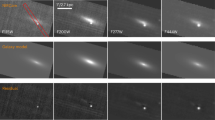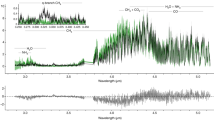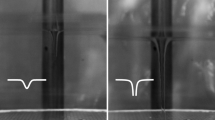Abstract
The host galaxy of the quasar SDSS J114816.64+525150.3 (at redshift z = 6.42, when the Universe was less than a billion years old) has an infrared luminosity of 2.2 × 1013 times that of the Sun1,2, presumably significantly powered by a massive burst of star formation3,4,5,6. In local examples of extremely luminous galaxies, such as Arp 220, the burst of star formation is concentrated in a relatively small central region of <100 pc radius7,8. It is not known on which scales stars are forming in active galaxies in the early Universe, at a time when they are probably undergoing their initial burst of star formation. We do know that at some early time, structures comparable to the spheroidal bulge of the Milky Way must have formed. Here we report a spatially resolved image of [C ii] emission of the host galaxy of J114816.64+525150.3 that demonstrates that its star-forming gas is distributed over a radius of about 750 pc around the centre. The surface density of the star formation rate averaged over this region is ∼1,000 year-1 kpc-2. This surface density is comparable to the peak in Arp 220, although about two orders of magnitude larger in area. This vigorous star-forming event is likely to give rise to a massive spheroidal component in this system.
year-1 kpc-2. This surface density is comparable to the peak in Arp 220, although about two orders of magnitude larger in area. This vigorous star-forming event is likely to give rise to a massive spheroidal component in this system.
This is a preview of subscription content, access via your institution
Access options
Subscribe to this journal
Receive 51 print issues and online access
$199.00 per year
only $3.90 per issue
Buy this article
- Purchase on Springer Link
- Instant access to full article PDF
Prices may be subject to local taxes which are calculated during checkout


Similar content being viewed by others
References
Bertoldi, F. et al. Dust and molecular emission from high-redshift quasars. Astron. Astrophys. 406, 55–58 (2003)
Beelen, A. et al. 350 micron dust emission from high-redshift quasars. Astrophys. J. 642, 694–701 (2006)
Walter, F. et al. Molecular gas in the host galaxy of a quasar at redshift z = 6.42. Nature 424, 406–408 (2003)
Bertoldi, F. et al. High-excitation CO in a quasar host galaxy at z = 6.42. Astron. Astrophys. Lett. 409, 47–50 (2003)
Maiolino, R. et al. First detection of [C ii] 158 µm at high redshift: vigorous star formation in the early universe. Astron. Astrophys. Lett. 440, 51–54 (2005)
Carilli, C. et al. Radio continuum imaging of far-infrared-luminous QSOs at z > 6. Astron. J. 128, 997–1001 (2004)
Downes, D. & Solomon, P. Rotating nuclear rings and extreme starbursts in ultraluminous galaxies. Astrophys. J. 507, 615–654 (1999)
Scoville, N. Z., Yun, M. S. & Bryant, P. M. Arcsecond imaging of CO emission in the nucleus of Arp 220. Astrophys. J. 484, 702–719 (1997)
Tielens, A. G. G. M. & Hollenbach, D. Photodissociation regions. I. Basic model. II. A model for the Orion photodissociation region. Astrophys. J. 291, 722–754 (1985)
Stacey, G. J. et al. The 158 micron forbidden C ii line—a measure of global star formation activity in galaxies. Astrophys. J. 373, 423–444 (1991)
Fan, X. et al. A survey of z > 5.7 quasars in the Sloan Digital Sky Survey. II. Discovery of three additional quasars at z > 6. Astron. J. 125, 1649–1659 (2003)
Fan, X. et al. Constraining the evolution of the ionizing background and the epoch of reionization with z ∼ 6 quasars. II. A sample of 19 quasars. Astron. J. 132, 117–136 (2006)
Iono, D. et al. A detection of [C ii] line emission in the z = 4.7 QSO BR 1202–0725. Astrophys. J. Lett. 645, 97–100 (2006)
Walter, F. et al. Resolved molecular gas in a quasar host galaxy at redshift z = 6.42. Astrophys. J. Lett. 615, 17–20 (2004)
Spergel, D. N. et al. Three-year Wilkinson Microwave Anisotropy Probe (WMAP) observations: Implications for cosmology. Astrophys. J. 170 (Suppl.). 377–408 (2007)
Wright, E. L. A cosmology calculator for the World Wide Web. Publ. Astron. Soc. Pacif. 118, 1711–1715 (2006)
Riechers, D. A., Walter, F., Carilli, C. & Bertoldi, F. observations of dense molecular gas in a quasar host galaxy at z = 6.42: Further evidence for a nonlinear dense gas–star formation relation at early cosmic times. Astrophys. J. Lett. 671, 13–16 (2007)
Omont, A. et al. A 1.2 mm MAMBO/IRAM-30 m survey of dust emission from the highest redshift PSS quasars. Astron. Astrophys. 374, 371–381 (2001)
Werner, M. W. et al. One arc-minute resolution maps of the Orion Nebula at 20, 50, and 100 microns. Astrophys. J. 204, 420–426 (1976)
Tacconi, L. et al. High-resolution millimeter imaging of submillimeter galaxies. Astrophys. J. 640, 228–240 (2006)
Thompson, T., Quataert, E. & Murrey, N. Radiation pressure-supported starburst disks and active galactic nucleus fueling. Astrophys. J. 630, 167–185 (2005)
Elmegreen, B. G. Galactic bulge formation as a maximum intensity starburst. Astrophys. J. 517, 103–107 (1999)
Gao, Y. & Solomon, P. M. HCN survey of normal spiral, infrared–luminous, and ultraluminous galaxies. Astrophys. J. 152 (Suppl.). 63–80 (2004)
Dekel, A. et al. Cold streams in early massive hot haloes as the main mode of galaxy formation. Nature 10.1038/nature07648 (in the press)
Walter, F. & Carilli, C. Detecting the most distant (z > 7) objects with ALMA. Astrophys. Space Sci. 313, 313–316 (2008)
White, R. L., Becker, R. H., Fan, X. & Strauss, M. A. Hubble Space Telescope Advanced Camera for Surveys observations of the z = 6.42 quasar SDSS J1148+5251: A leak in the Gunn–Peterson trough. Astron. J. 129, 2102–2107 (2005)
Solomon, P. M. & Vanden Bout, P. A. Molecular gas at high redshift. Annu. Rev. Astron. Astrophys. 43, 677–725 (2005)
Malhotra, S. et al. Infrared Space Observatory measurements of [C ii] line variations in galaxies. Astrophys. J. 491, 27–30 (1997)
Luhman, M. L. et al. Infrared Space Observatory measurements of a [C ii] 158 micron line deficit in ultraluminous infrared galaxies. Astrophys. J. Lett. 504, 11–15 (1998)
Acknowledgements
This work is based on observations carried out with the IRAM Plateau de Bure Interferometer. IRAM is supported by MPG (Germany), INSU/CNRS (France) and IGN (Spain). D.R. acknowledges support from NASA through a Hubble Fellowship awarded by the Space Telescope Science Institute, which is operated by the Association of Universities for Research in Astronomy, Inc., for NASA. C.C. acknowledges support from the Max-Planck Gesellschaft and the Alexander von Humboldt Stiftung through the Max-Planck-Forschungspreis 2005. F.W. and D.R. appreciate the hospitality of the Aspen Center for Physics, where this manuscript was written.
Author information
Authors and Affiliations
Corresponding author
PowerPoint slides
Rights and permissions
About this article
Cite this article
Walter, F., Riechers, D., Cox, P. et al. A kiloparsec-scale hyper-starburst in a quasar host less than 1 gigayear after the Big Bang. Nature 457, 699–701 (2009). https://doi.org/10.1038/nature07681
Received:
Accepted:
Issue Date:
DOI: https://doi.org/10.1038/nature07681
This article is cited by
-
Rapidly star-forming galaxies adjacent to quasars at redshifts exceeding 6
Nature (2017)
-
A dust-obscured massive maximum-starburst galaxy at a redshift of 6.34
Nature (2013)
-
The intense starburst HDF 850.1 in a galaxy overdensity at z ≈ 5.2 in the Hubble Deep Field
Nature (2012)
-
Intense star formation within resolved compact regions in a galaxy at z = 2.3
Nature (2010)
Comments
By submitting a comment you agree to abide by our Terms and Community Guidelines. If you find something abusive or that does not comply with our terms or guidelines please flag it as inappropriate.



